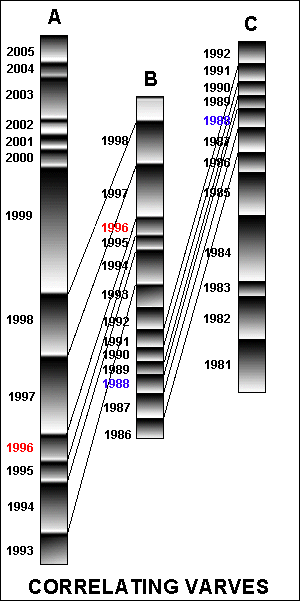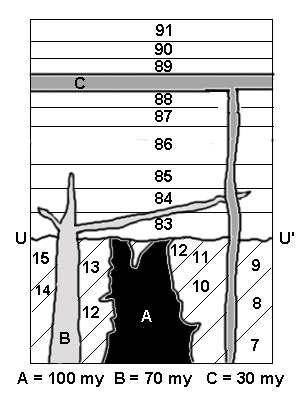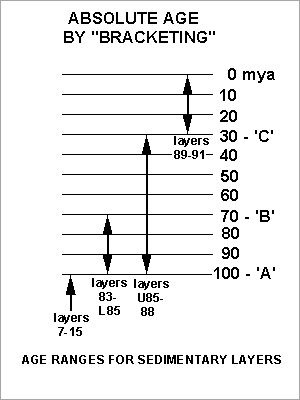| TIME - CONTINUED INTRODUCTION |
| We have already discussed determining the relative ages of events. We will now discuss absolute age determination, which assigns a quantitative estimate of the number of years ago an event occurred.
|
|
ABSOLUTE AGE DETERMINATION
A. SIMPLE COUNTING
|
- For a series of horizontal, depositional layers that are not overturned, the relative age of each layer with respect to the other layers is known. What may not be known is the actual number of years ago any of the layers formed (their absolute ages).
- However, in some circumstances, the absolute age may be readily determined. Consider the layers of sediment deposited by the Nile River on the surrounding flood plain. Before the completion of the Aswan High Dam in 1970, a new layer of soil was deposited every year during annual flooding. To determine the age of any layer, all that needed to be done was to count down from the top. That is, for a series of layers deposited at regular, known intervals, the age of any layer is the length of the interval multiplied by the number of layers lying above it.
- If the process ceases (that is, no more layers are being deposited), then the age of any layer is the length of the interval multiplied by the number of layers lying above it, plus the length of time that has elapsed since the process ceased. In the case of the layers that make up the floodplain of the Nile, the age of any layer is the length of the interval (one year) multiplied by the number of layers lying above it, plus the time elapsed since the building of the Aswan Dam (the present year [2005] minus 1970 = 35 years. Thus, the fourth layer down would have an absolute age of (4 x 1) plus 35 = 39 years old. (In actuality, the Aswan Dam was built in several stages, starting in 1889, so the interval between deposition of the uppermost layers is actually irregular, voiding simple application of the formula.)
|
|
B. SIMPLE COUNTING PLUS 'PATTERN MATCH' |
- In regions such as Scandinavia, glacial ice undergoes melting every spring and summer. The meltwaters carry away sediment that was trapped in the ice. Where the sediment-laden meltwaters flow into a lake, a layer of sediment is deposited on the lake floor every year. Coarse sediment is deposited quickly; fine sediment remains suspended in the water until it has a chance to gradually settle out during the cold months when the surface of the lake is frozen over and the water is quiet. Each annual layer, therefore, has two parts: a thick coarse sandy layer overlain by a thinner, fine clayey layer. The coarse-fine couplet is known as a varve ('varv' is Swedish for 'layer'). If the process of annual varve deposition continues today, simple counting can reveal the absolute age of any layer within the lake basin.
|

VARVES
Courtesy Natural Resources Canada
(Geological Survey of Canada, photo number kgs156) |
- If annual deposits are no longer being made in a particular lake basin, then the length of time that has elapsed since the top layer was deposited must be determined in some other fashion. (Deposition of varves may cease because the glaciers have melted away completely or because the lake basin has been completely filled by sediment.)
- Because varve thicknesses vary randomly from year to year, depending upon regional weather conditions, it may be possible to determine the length of time that has elapsed since the top layer was deposited in a place where annual deposition no longer occurs. Such determination may be accomplished by a process of 'pattern matching correlation' with layers that have accumulated at a place where annual deposition continues.
- Consider the varve sequences at locations A, B and C. At A, yearly deposition continues, so the absolute ages of layers can be determined by counting down from the top. At locations B and C, deposition stopped at some time in the past. Indeed, some of the top layers may have been removed by erosion. However, by pattern matching, five layers at the bottom of A can be correlated with five layers at the top of B.
Similarly, by pattern matching, five layers at the bottom of B can be correlated with five layers at the top of C. Since the ages of the layers at A are known by counting down from the top, layers at B that correlate with them can also be assigned ages. Then, the ages of the rest of the layers at B may be determined by counting down. In similar fashion, layers at C that correlate with layers at B may be assigned ages, and the rest of the layers at C may be assigned by counting down.
- It is important to note that the thickness of the equivalent layers in the different locations need not be the same. Upon examination, it may be seen that all the layers at A are thicker than their equivalents at B. It is the ratios of thicknesses, not the actual thicknesses that are important.
For example, if the spring and summer of a given year are warm, a one-inch thick varve may form at A and a one-half inch thick varve at B. If the summer and spring of the following year are cooler, a one-half inch thick varve may form at A and a one-quarter inch thick varve at B. But the varve thickness ratios of the first (warm) year to the second (cool) year will be 2:1 in both places. Remember, it is not by matching thicknesses of individual varves that correlation is accomplished, but by matching ratios of varve thicknesses at different locations.
- Using this method, ages of varves that formed tens of thousands of years ago may be determined. For example, varves close to forty thousand years old have been dated in Japan.
- Pattern matching is also used to date trees by examining growth rings (dendrochronology). Ages up to 14,000 years have been determined in this fashion.
|  
| |
|
C. RADIOMETRIC DATING |
'Simple counting' and 'pattern match' methods of determining absolute age have as their advantage that, with proper precautions, they can provide accurate ages without the use of sophisticated technology. Indeed, dating of lake sediments using varves was undertaken as early as 1879.
Their disadvantage is that they are restricted to sites where annual deposition has occurred and the absolute age of at least one layer can be determined with confidence by some other means (for example, places where annual deposition continues through to today). Places satisfying these requirements are relatively few. Another disadvantage is that over geologic time, preservation of such layers is limited, and absolute age determination by varve counting is only suitable for materials less than several tens of thousands of years old.
These limitations are overcome in radiometric dating. Radioactive elements, such as certain isotopes of uranium, thorium, rubidium, potassium, carbon and others, have the property that over set periods of time, known as their 'half lives', half of their atoms decay to form atoms of different elements. For example, over the course of 704 million years, half the atoms of the 'parent' element uranium-235 (U-235) decay to form atoms of lead-207 (Pb-207). Over the next 704 million years, half of the remaining U-235 atoms change to Pb-207, and so on. By comparing the ratios of U-235 to Pb-207 that are found in the material today, the time when the process started may be ascertained (see table below).
Examples of radioactive parent-daughter pairs and their half lives include:
- U-238 - Pb-206 (4.5 billion years)
- U-235-Pb-207 (704 million years)
- Rb-87 - Sr-87 (48.8 billion years)
- K-40 - Ar 40 (1.25 billion years)
- C-14 - N-14 (5730 years)
The error for radiometric dating is typically about 1 %. Thus, for a material whose age is determined to be 2 billion years old, the error may be on the order of plus/minus 20 million years. An error of that magnitude may be quite acceptable for such old rocks. It is important to choose a radioactive parent-daughter pair whose half life is appropriate for the age of the material being dated. On the one hand, the half life should be short enough so that a measurable amount of the daughter element has formed. On the other hand, if the half life is too short, the amount of parent element left may not be measurable. Thus, K-Ar dating would not be appropriate for a material that is 50,000 years old, as hardly any daughter element would have formed. Similarly, C-14 dating is not be appropriate for materials older than about 70,000 years as the amount of the parent element left becomes too small to be measured accurately.
|
 |
Radiometric dating depends on certain assumptions. - The most fundamental assumption is that the half life of a parent-daughter pair does not change through time. Experimentally and theoretically, that assumption seems justified. Also, successfuly cross-checking ages by using different dating techniques on the same sample supports the constancy of half lives. For example, C-14 dates may be checked against ages determined through varve counting.
- A second assumption is that the system is closed. That is, no parent or daughter material has been added to or lost from the material being dated. Such addition or subtraction may occur if the material (mineral or rock) has been weathered or metamorphosed. Therefore, material to be dated must be carefully examined to determine whether such processes may have taken place.
Igneous rocks and highly metamorphosed rocks are the best candidates for radiometric dating.
Igneous Rocks: The 'age' of an igneous rock refers to the time when the magma or lava from which it formed cooled below a certain temperature. A useful material for dating that time is the mineral zircon, a minor but common constituent of igneous rocks. As magma or lava solidifies, the elements zirconium (Zr), silicon (Si) and oxygen (O) link together to form zircon crystals. If uranium (U) atoms are in the vicinity, they may be incorporated into the zircon in place of Zr atoms. This substitution is possible because the size and charge of the U is similar to that of Zr. That is, the U can 'fit' in the sites normally occupied by Zr. However, if there is lead (Pb) in the vicinity, it cannot be incorporated in the zircon because it can't 'fit' in any of the sites. Assuming the zircon has not been affected by weathering or metamorphism, any Pb subsequently found in the zircon must have come from decay of the U; it was not there to start with. Determination of the Pb-207/U-235 ratio in the zircons gives their age and thus the age of the igneous rock in which they occur. (It is true that not all minerals that crystallize from a magma or lava form simultaneously, but except for extremely young igneous rocks, the time required for solidification is very short compared compared to the age of the rock.)
Metamorphic Rocks: Accurate radiometric dating of metamorphic rocks is more difficult. During metamorphism, preexisting minerals may be altered and new minerals may be formed. For preexisting minerals, there is the distinct possibility that during metamorphism, parent or daughter elements may have been added or lost. If this happens, attempts to determine an accurate original (premetamorphic) age of the material will be frustrated. For example, loss of some of the daughter element will give a deceptively young age; addition of daughter element will give a deceptively old age.
However, if the rock is highly metamorphosed, the situation is more propitious. For example, in the K-Ar system, all of the daughter element (Ar) may be lost from some preexisting minerals. Or else, completely new mineral grains may develop that contain the parent element (K) but totally lack the daughter element (Ar). In either case, these minerals constitute new 'closed' systems that, if dated, give the age of the metamorphic event.
Sedimentary Rocks: The age of a sedimentary rock refers to the time when loose sediment is turned into rock (becomes 'lithified'). Sedimentary rocks are varied and complex, but for many of them, the sedimentary particles out of which they are made consist of material eroded from prexisting rocks. After transportation and deposition, the particles are bound together in some fashion, perhaps by a 'cement'. If the particles are dated, the ages obstained refer to the ages of the rock from which they were derived. Thus, for many sedimentary rocks, the constitutent grains have widely varying ages. To get the age of the sedimentary rock itself, the material dated has to have formed at the time of consolidation of the rock. For most sedimentary rocks, there is no such material that is datable (contains suitable parent-daughter elements). Sedimentary rocks must, therefore, be dated by 'bracketing'.
|
| "BRACKETING" |
| Consider the geologic cross section to the right. The numbered layers are sedimentary rocks; A and B are igneous intrusives; C is a lava flow with its 'feeder pipe'; U-U' is an unconformity (buried erosion surface).
The relative ages of events are as follows:
- deposition of layers 7 through 15+
- tilting of layers 7 through 15+
- intrusion of A
- erosion down to U-U'
- deposition of 83 through 88
- intrusion of B some time after deposition of lower 85 and before extrusion of C
- extrusion of C
- deposition of 89-91
|
 |
|
The absolute ages of igneous rocks A, B, and C are determined by radiometric dating: - A = 100 million years (my)
- b = 70 mya
- C = 30 mya
The ages of the igneous rocks place limits on the ages of the sedimentary layers. That is, the ages of the sedimentary rocks are 'bracketed' between the ages of the igneous rocks:
- layers 7 through 15 are older than A, thus older than 100 my.
- layers 83 through lower 85 are younger than A but older than B, thus they are younger than 100 my but older than 70 my.
- layers upper 85 through 88 are younger than A but older than C, thus they are younger than 100 my but older than 30 my.
- layers 89 through 91 are younger than C, thus younger than 30 my.
|  |
|
| As the ages of sedimentary layers in contact with dated igneous rocks are 'bracketed', their ages may be assigned to sedimentary layers with which they have been correlated by means of fossils or other methods. |
|
C. OTHER ABSOLUTE AGE DATING TECHNIQUES |
| The United States Geological Survey provides simple descriptions of other techniques for determining absolute age.
| |
SCIENCE-CREATIONIST CONTROVERSY |
| On the web, you will find a raging debate between geochronologists (geologists who determine absolute ages) and creationists and supporters of 'intelligent design' who deny the validity of absolute age dating techniques. For a discussion of the debate,
click here.
|
|